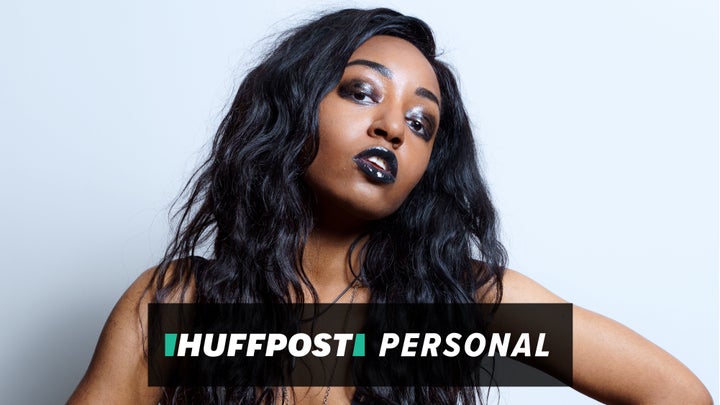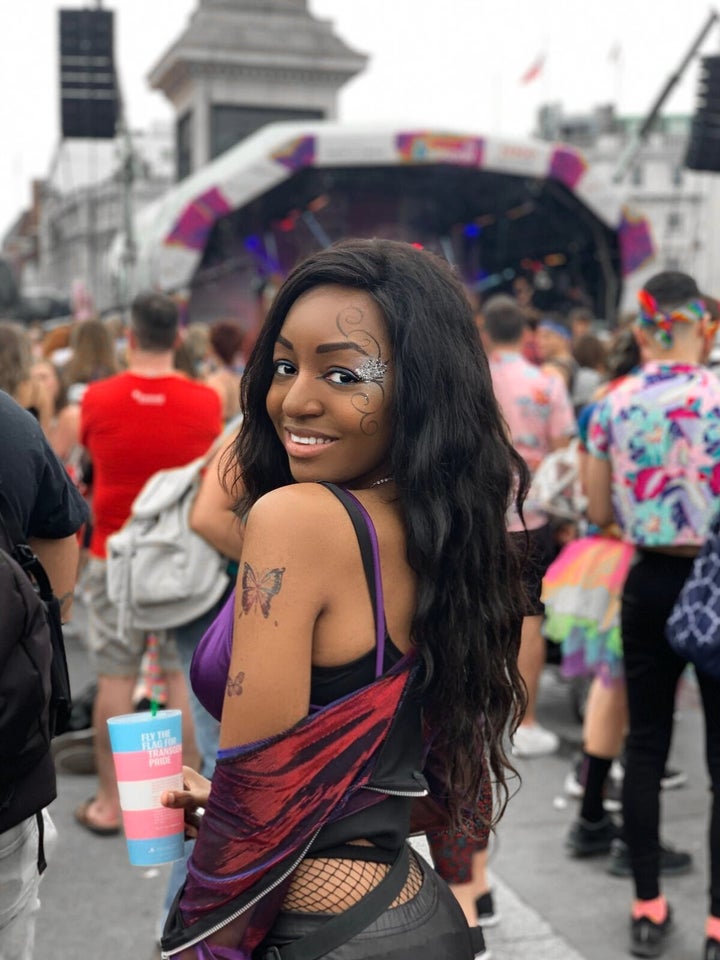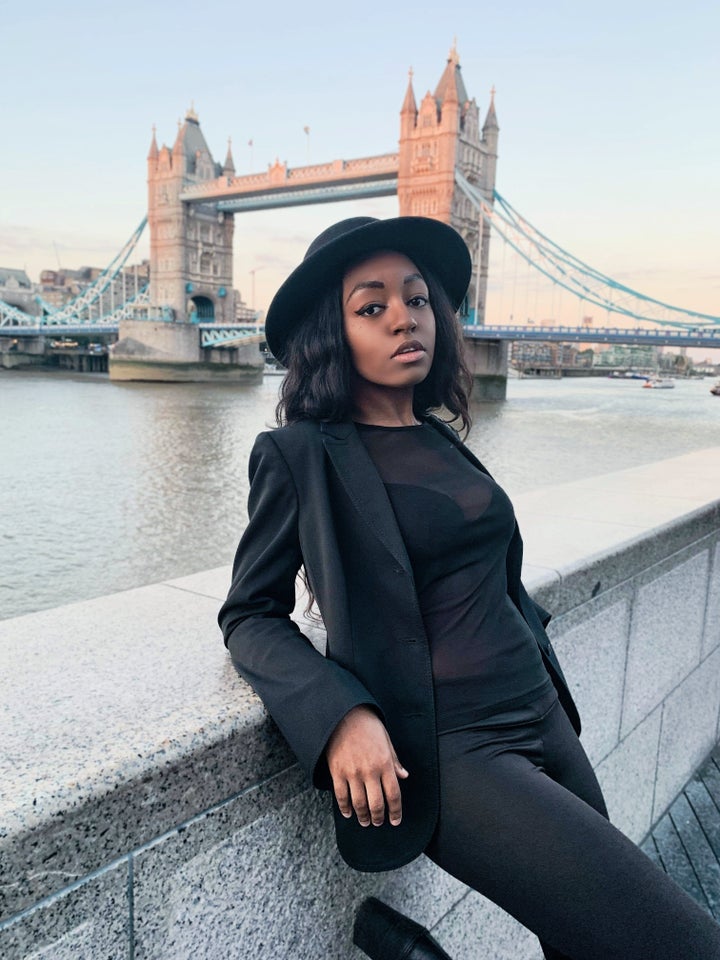
Having realised that I was asexual at a young age, my asexuality has never been a mystery to me. It means that I don’t experience sexual attraction. Being aromantic as well, I don’t experience romantic attraction either. In my private life, it was more-or-less common knowledge. I didn’t date and there had never been a period where I expressed an interest in anyone, not even as a ‘hormonal’ teenager.
However, in the public sphere of my work as a model, it took me a long time to announce it. I don’t believe that anyone has to announce their sexuality (or lack of it), but staying quiet meant that there was an unwanted disparity between my public persona and my private one. I didn’t feel like I was being true to myself.
I believe in being the change you want to see. I started modelling with the goal of providing representation for alternative black women, and showing that you don’t need to be a white to be alternative. At the same time, I was consciously aware of the lack of representation for asexual people – especially asexual people of colour. And I was doing nothing about it, even though the lack of visibility for asexual people led to my own alienation, and the alienation of many others like myself.
“I don’t believe that anyone has to announce their sexuality (or lack of it), but staying quiet meant that there was an unwanted disparity between my public persona and my private one”
In 2017, I came out publicly (on YouTube like a good millennial), with a video on entitled, Things Asexual Girls Don’t Like to Hear. Much to my surprise, it launched my journey into asexuality activism. From speaking at universities and Pride events, to appearing in corporate campaigns and documentaries, attending events, writing articles like these, and even working on an asexuality radio series, I unwittingly found myself becoming a voice for our community.
And while pushing forward in my campaigning, I’ve also continued to push forward with my modelling career, and caused confusion as a result. “If you’re asexual, why do you do lingerie shoots?” is a common comment I hear a lot. To many people, it’s as though being asexual and a lingerie model doesn’t make sense – as though the two are completely incompatible.
Truthfully, I can understand why people have that impression. Modelling is seen by many as a sexualised industry, and even in 2019, people assume that women dress with the intent of attracting men. So if I don’t feel sexual attraction and I’m not trying to attract men, why would I model for lingerie designers?
There was a time where there was a conflict of interest for me as well.

“Look at the camera like it’s your boyfriend…”
I used to hear that line a lot from male photographers during my early modelling days when lingerie and boudoir modelling was my main focus. It was their way of telling me to flirt with the camera, to appear more sensual and create the illusion the photos we were shooting were part of an intimate scenario for our predominantly male audience.
At the time, I was under the impression that lingerie shoots were the only jobs I would be able to book – I was too short for the catwalk and too curvy for many of the fashion genres – but I struggled to meet the expectations of the male photographers. Such comments had me thinking, “I don’t know how I’d look at a boyfriend, I don’t have boyfriends, and I’m not interested in having a boyfriend.” But, of course, I felt like I couldn’t say that, so I pretended.
I feel like I did a lot of pretending back them. Arguably, models are meant to pretend; it’s just part of the job in order to sell the product or the idea. But the idea I was selling was that I was a lustful damsel waiting to be ravished. Feigning sexualised feelings specifically to titillate a male audience as an asexual person, to me, was comparable to being vegan and modelling for Burger King... over and over again. Not just smiling with a burger, but expressing a sincere, lustful longing for a burger.
“Others in the industry had made comments that my work wasn’t provocative or suggestive enough and that I would need to up my game”
The photographers I worked with had no negative criticisms about my performance, but others in the industry had made comments that my work wasn’t provocative or suggestive enough and that I would need to up my game to compete against models who were willing to do more.
After coming out publicly, I had to re-evaluate my approach to modelling, specifically the more risqué genres. I decided that I would not participate in shoots that were designed by someone else specifically to stir another’s sexual fantasies. When I do lingerie shoots now, it’s because the lingerie compliments the vibe of the shoot, and because I’m a fan of the lingerie designer and their work aligns with my personal ethos.
As you would expect, this made me feel more true to myself in my work, but it also cost me a lot of opportunities. The most devastating was when I had the opportunity to model for a British brand that I had been a fan of since I was a teenager. I had spent years trying to get their attention but when I finally did, I had to turn it down. The shoot was specifically for their lingerie line’s Valentine’s campaign, and I would have to play a submissive partner in their BDSM theme. I haven’t had the opportunity to model for them again.
However, I have still had the opportunity to work on other incredible shoots since then, and I’ve grown even more confident in the fact that asexuality and lingerie modelling are not incompatible. Nowadays, I’m aware that my work as a model and an activist is sometimes used for shock value. Having an image of me in lingerie with a headline about me being asexual is practically clickbait – the controversy of such an idea is what grasps the audience’s attention. But I believe this is something that can be used to the whole community’s advantage.

In fact, I believe that the way I live my life contributes to a deeper understanding of asexual people in a positive way, and challenges the preconceived notions that people have about us. Whenever I’m told that I don’t “look asexual,” I know that I have the opportunity to change someone’s ideas about what an asexual person looks like and how we’re ‘meant’ to present ourselves. Asexual people can be good looking, we can dress up, wear makeup, wear fitted clothes, style our hair, and still not be sexually attracted to anyone. We can be confident in the bodies that society tells us is ‘broken’ or ‘useless’ or not worth their time.
The idea of never shooting lingerie again after coming out never crossed my mind. Let’s be honest, in our society people sexualise anything, no matter what you’re wearing, no matter how you appear, no matter how you behave – especially if you’re a woman, and even more so when you’re a black woman. While I avoid participating in photoshoots aimed at sexually enticing others, I’m not going to restrict my self-expression for the sake of not confusing simple-minded people.
That would be the bigger betrayal of who I really am.
Yasmin Benoit is a model, blogger, speaker and asexuality activist
Have a compelling personal story you want to tell? Find out what we’re looking for here, and pitch us on ukpersonal@huffpost.com